-
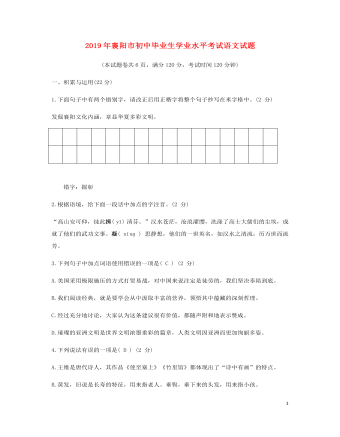
湖北省襄阳市2019年中考语文真题试题
钱学森经历了重重的艰难险阻后,终于回到了祖国。回国后他受到了最高规格的待遇,主席经常和他在一起,讨论国家以后的发展。主席曾经问过钱学森,为什么要执意回国,美国的待遇这么好,回来后悔吗?钱学森异常认真地说:“苟利国家,不求富贵。”八个字掷地有声,听者无不为其鼓掌。2018年 10月11日下午,在边境扫雷行动中,面对复杂雷场中的不明爆炸物,杜富国对战友大喊:“你退后, 让我来!”在进一步查明情况时突遇爆炸,他英勇负伤,失去双手和双眼,同组战友安然无恙。“我只是做了一个军人应该做的选择。”这个阳光帅气的小伙,对雷场救下战友这个选择,从未后悔过。
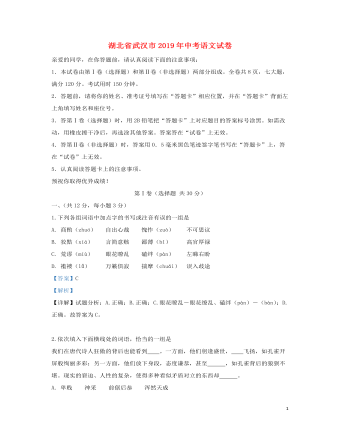
湖北省武汉市2019年中考语文真题试题(含解析)
“鱼跃练川抛玉尺,莺穿丝柳织金梭。”一条鱼跃过像白绸一样的水面,如同一根玉尺抛在白绸子上;黄莺穿过像丝一样的柳条,像一枚金梭在许多条丝线中穿织。你看,多么漂亮,而且对仗工整,但只是描述风景外在的形象,没有内心的感动。这样,即使写出再漂亮的句子,也只有文字和技巧,缺乏诗歌应有的生命。“群鸡正乱叫”是杜甫的诗句,只看这一句,好像不是好诗。但读诗不能只看一句,要看整体的传达。《羌村》整组诗,表现的是诗人历经战争离乱,与妻子儿女长期分别后回家重逢的情形,“群鸡正乱叫”这句诗就有了一种朴实真切的叙写,更有一份亲切热烈的感情。
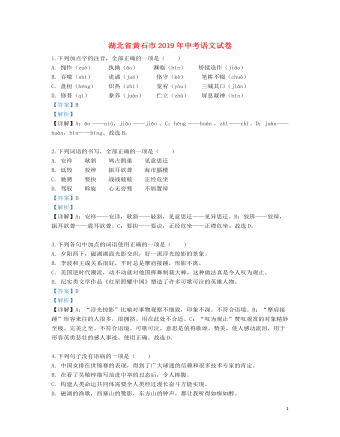
湖北省黄石市2019年中考语文真题试题(含解析)
奇异果的第一站从它的发源地一—湖北宜昌市夷陵区开始。谁是尝鲜这种果子的第一人已无从得知,然而它流传最广的名字却是“猕猴桃”:一说是,这种果子外皮一层绒毛,状似猕猴而得名;而另一种说法则称是因为生长在山间的果实常被猕猴食用。这名称一直沿用至今。发源于夷陵山间的猕猴桃,在数千年间缓慢地持续着它的旅程一向北延伸到陕西、甘肃、河南一带;向西南去往贵州、云南和四川,在长江中下游流域,尤其夷陵区雾渡河最为多见。虽然历史记载源远流长,但我国的猕猴桃却一直都未被驯化栽培。野外的猕猴桃,如果生在深山中,多被猴子们摘去果腹;即使被少数人家移植到庭院里,猕猴桃也只是用来观赏而非食用。归根结底,直到几十年前,猕猴桃在国内还只是一种野果。
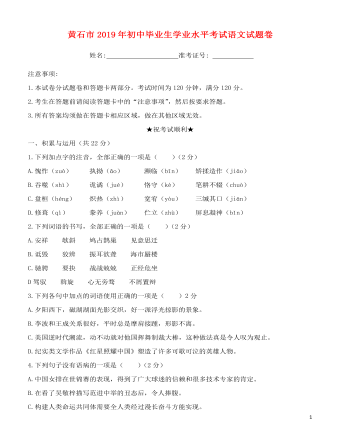
湖北省黄石市2019年中考语文真题试题
奇异果的第一站从它的发源地一—湖北宜昌市夷陵区开始。谁是尝鲜这种果子的第一人已无从得知,然而它流传最广的名字却是“猕猴桃”:一说是,这种果子外皮一层绒毛,状似猕猴而得名;而另一种说法则称是因为生长在山间的果实常被猕猴食用。这名称一直沿用至今。发源于夷陵山间的猕猴桃,在数千年间缓慢地持续着它的旅程一向北延伸到陕西、甘肃、河南一带;向西南去往贵州、云南和四川,在长江中下游流域,尤其夷陵区雾渡河最为多见。虽然历史记载源远流长,但我国的猕猴桃却一直都未被驯化栽培。野外的猕猴桃,如果生在深山中,多被猴子们摘去果腹;即使被少数人家移植到庭院里,猕猴桃也只是用来观赏而非食用。归根结底,直到几十年前,猕猴桃在国内还只是一种野果。
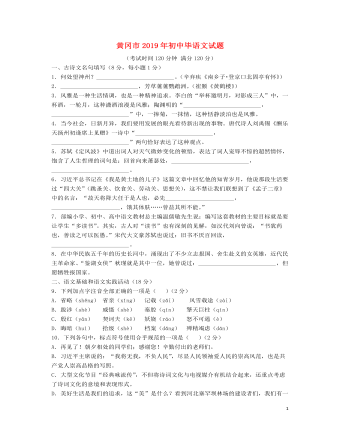
湖北省黄冈市2019年中考语文真题试题
我常想,读书人是世间幸福人,因为他除了拥有现实的世界之外,还拥有另一个更为浩瀚也更为丰富的世界。现实的世界是人人都有的,而后一个世界却为读书人所独有。由此我想,那些失去或不能阅读的人是多么的不幸,它们的丧失是不可补偿的。世间有诸多的不平等,财富的不平等,权力的不平等,而阅读能力的拥有或丧失却体现为精神的不平等。一个人的一生,只能经历自己拥有的那一份欣悦,那一份苦难,也许再加上他亲自感知的那一些关于自身以外的经历和经验。然而,人们通过阅读,却能进入不同时空的诸多他人的世界。这样,具有阅读能力的人,无形间获得了超越有限生命的无限可能性。阅读不仅使他认识了草木虫鱼之名,而且可以上溯远古下及未来,饱览存在的与非存在的奇风异俗。
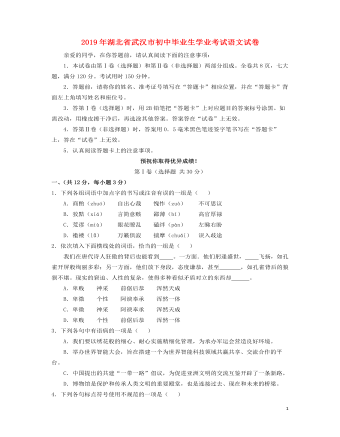
湖北省武汉市2019年中考语文真题试题
回乡过年,带小外甥去小店买花炮,回来路上听见有人喊他名字,我正要回头,却听小外甥压低声音说,快走。我还没反应过来,他已经一溜烟跑回家了。我转过头,看见一个和他年龄相仿的小男孩愣愣地站在远处,无所适从的样子。 回到家里,小外甥说那是他同学,不过大家都不跟那小男孩玩。小男孩有时撵着跟人家玩,有时候又会莫名其妙地骂人,甚至动手,下手还特别重,有次把一个男生的耳朵都打出血了。 为什么会这样呢?小外甥的爸爸告诉我,小男孩没人管,妈妈几年前就没了,爸爸在外面打工,也不怎么回来,他跟着爷爷奶奶住。
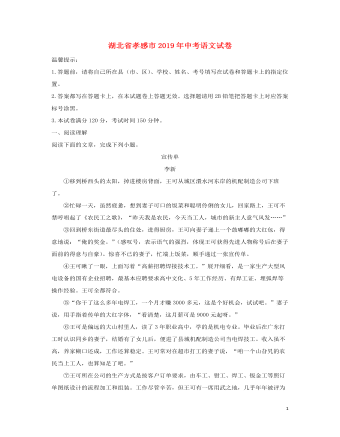
湖北省孝感市2019年中考语文真题试题(含解析)
文人收藏紫砂壶,已不仅仅是为了品茶,更是为了在闲暇之余,在竹影琳琅、绿影映墙之时,拿在手里细细把玩,修身养性、涵养品德。紫砂壶也因之成为文人梦寐以求的茶具,甚至千金难求,罕如美玉。紫砂壶名家供春所制紫砂壶,清朝时期成为极品。雍正年间的状元周澍曾得到一款供春的紫砂壶,绘画著文之余,泡茶独品,清雅非常。此壶价钱,用他的文字描述:“供春小壶一具,用之数年,则值金一笏。”
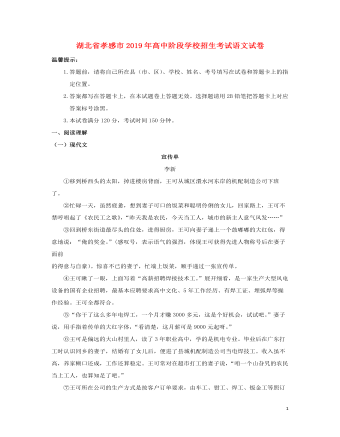
湖北省孝感市2019年中考语文真题试题
一个茶人,拿着一把紫砂壶,泡上一壶茶,坐在古柳大树下的青石上,有一口没一口地喝着,简直是山水田园般的生活。这一刻,什么名利,什么得失,都已了无踪迹,心中唯有茶花如雪,清香细细,唯有蝉鸣声声,山泉溅溅。周作人说:“喝茶当于瓦屋纸窗之下,清泉绿茶,用素雅的陶瓷茶具,同二三人共饮,得半日之闲,可抵十年的尘梦。”这不是山中饮茶,是都市茶寮饮茶。山中饮茶,当用紫砂壶,与田园生活,与篱笆豆角的山村风光很是吻合。
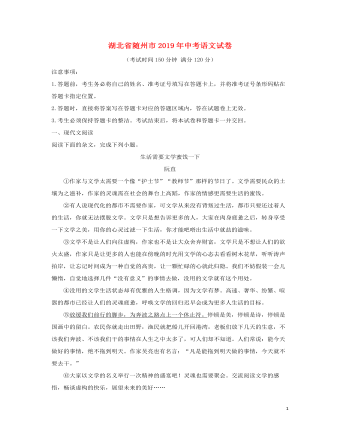
湖北省随州市2019年中考语文真题试题(含解析)
故乡的风之所以气势恢宏,是其中的沙尘充当了风的武器。那时的风与沙尘,像是从未分开过。风力助推沙尘漫天席卷,掀翻了街口摆着糖果的摊板,刮跑了老爷爷头上的帽子。偶尔看见骑自行车的人,在风里歪扭一阵之后,不得不屈尊下驾,吃力地推车前行。有时在教室里正聚精会神地听讲,风猛然用力,让玻璃飞出窗框,在书桌上和地上“哗”地破碎。我和同伴们对风的防御,最早使用的是风镜。顾名思义,风镜就是防风的眼镜。玻璃镜片镶在细细的钢丝框上,四周有密织的布罩,两端用皮筋连接,套在头上拉至眼部,风便吹不着眼睛了。每副风镜五分钱,后来有了塑料的镜片,价格要高出很多。戴风镜并不完全是为了防风,重点是防风里的沙子。
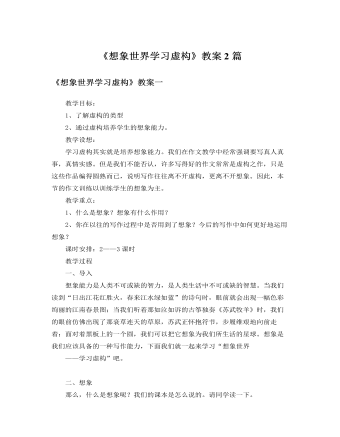
人教版高中语文必修2《想象世界学习虚构》教案2篇
虚构不等于说假话。它是一种源于生活,但高于生活的艺术真实。我们可以举个例子:我国公认的最权威最真实的史书是——《史记》,那么,大家认为《史记》里有没有虚构呢?有。必修一的《鸿门宴》里就有虚构。大家想:司马迁是哪个朝代的人?西汉汉武帝时。刘邦项羽是哪个朝代的?秦末时期。那司马迁不可能坐时光穿梭机到秦末去参加鸿门宴吧?既然他没不在场,那课文《鸿门宴》里人物的语言、动作、甚至是表情从何而来呢?对,是司马迁根据有限的史料加以补充,想象、虚构出来的。那么,同学们在写作文时,也可以不必拘泥于亲身经历的事情,毕竟生活是平淡的,毕竟大家的生活阅历也有限,有时候,我们发挥想象、虚构一个故事来反映生活的真实,也许更生动、也更典型。所以,近年来高考试卷中都提示考生:作文可以大胆想象,编写故事。按照编故事的方式不同,我们的虚构性作文又可以写哪些类型呢:小说,散文,童话,寓言,科幻,故事新编……
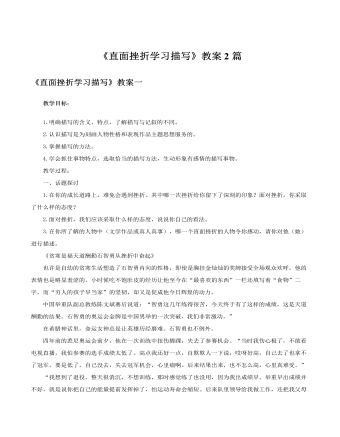
人教版高中语文必修2《直面挫折学习描写》教案2篇
《贫寒是福天道酬勤石智勇从挫折中奋起》也许是自幼的贫寒生活塑造了石智勇内向的性格,即使是胸挂金灿灿的奖牌接受全场观众欢呼,他的表情也是略显羞涩的。小时候吃不饱肚皮的经历让他至今在“最喜欢的东西”一栏还填写着“食物”二字,而“穷人的孩子早当家”的坚韧,却又是促成他今日辉煌的动力。中国举重队副总教练陈文斌赛后说道:“智勇这几年练得很苦,今天终于有了这样的成绩,这是天道酬勤的结果。石智勇的奥运会金牌是中国男举的一次突破,我们非常激动。”在希腊神话里,命运女神总是让英雄历经磨难。石智勇也不例外。四年前的悉尼奥运会前夕,他在一次训练中扭伤脚踝,失去了参赛机会。“当时我伤心极了,不敢看电视直播,我怕参赛的选手成绩太低了。高点我还好一点,自欺欺人一下说,哎呀好高,自己去了也拿不了冠军,要是低了,自己没去,失去冠军机会,心里痛啊。后来结果出来,也不怎么高,心里真难受。”
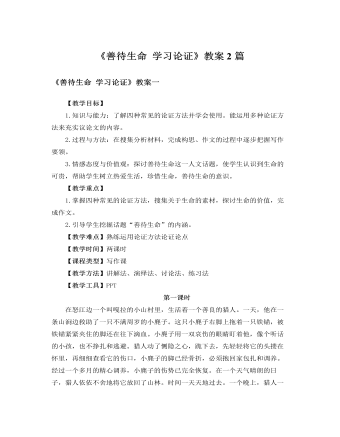
人教版高中语文必修3《善待生命 学习论证》教案2篇
论证方法之引证法如何用好引证法:1.所引用的名言警句等针对性要强。每句名言都产生于特定的背景,都应用于特定的交际目的,即使谈同一个问题,也有不少名言可供选取。2.要简洁,不宜过多。议论是在发表自己的见解而不是在介绍他人的见解。引用他人的话,目的是为了让读者更加信服自己的话。3.要注意直接引用和间接引用的区别。直接引用务求文字、甚至标点均准确无误;间接引用只须述其大意,但要注意人称的转换。论证方法之喻证法喻证法是用设喻来论证论点的方法。在议论文中,设喻可以使论点更易懂、更风趣、更容易获得读者的认同。喻证法能化抽象为具体、化艰深为浅显、化枯燥为生动。论证方法之喻证法如何用好喻证法:1.以小见大,就近取譬。要精选生活中细小的、人们熟悉的事物做为设喻的喻体。2.喻体不求形似,只求神似。做为喻证的喻体与做为比喻的喻体不同。比喻的喻体是为了强调特征,描绘事物,侧重形似,以形比形;而喻证的喻体是为了阐发观点,以正视听,力求神似,以义取形。
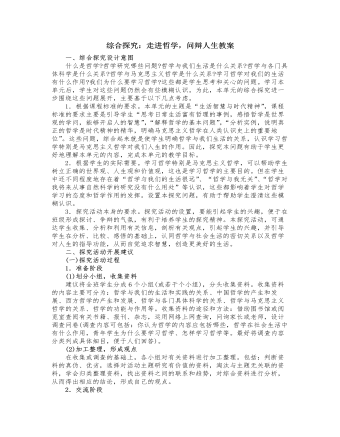
人教版高中政治必修4综合探究:走进哲学,问辩人生教案
1.根据课程标准的要求。本单元的主题是“生活智慧与时代精神”,课程标准的要求主要是引导学生“思考日常生活富有哲理的事例,感悟哲学是世界观的学问,能够开启人的智慧”,“解释哲学的基本问题”,“分析实例,说明真正的哲学是时代精神的精华,明确马克思主义哲学在人类认识史上的重要地位”。这些问题,综合起来就是使学生明确哲学与我们生活的关系,认识学习哲学特别是马克思主义哲学对我们人生的作用。因此,探究本问题有助于学生更好地理解本单元的内容,完成本单元的教学目标。2.根据学生的实际需要。学习哲学特别是马克思主义哲学,可以帮助学生树立正确的世界观、人生观和价值观,这也是学习哲学的主要目的。但在学生中还不同程度地存在着“哲学与我们的生活很远”、“哲学与我无关”、“哲学对我将来从事自然科学的研究没有什么用处”等认识,这些都影响着学生对哲学学习的态度和哲学作用的发挥。设置本探究问题,有助于帮助学生澄清这些模糊认识。
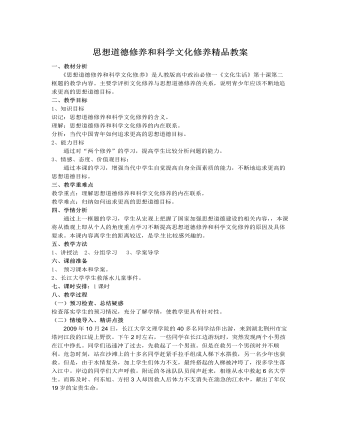
人教版高中政治必修3思想道德修养和科学文化修养精品教案
一、教材分析《思想道德修养和科学文化修 养》是人教版高中政治必修一《文化生活》第十课第二框题的教学内容。主要学评析文化修养与思想道德修养的关系,说明青少年应该不断地追求更高的思想道德目标。二、教学目标1、知识目标识记:思想道德修养和科学文化修养的含义。理解:思想道德修养和科学文化修养的内在联系。分析:当代中国青年如何追求更高的思想道德目标。2、能力目标通过对“两个修养”的学习,提高学生比较分析问题的能力。3、情感、态度、价值观目标:通过本课的学习,增强当代中学生自觉提高自身全面素质的能力,不断地追求更高的思想道德目标。三、教学重难点教学重点:理解思想道德修养和科学文化修养的内在联系。教学难点:归纳如何追求更高的思想道德目标。四、学情分析通过上一框题的学习,学生从宏观上把握了国家加强思想道德建设的相关内容,,本课将从微观上即从个人的角度重点学习不断提高思想道德修养和科学文化修养的原因及具体要求。本课内容离学生的距离较近,是学 生比较感兴趣的。
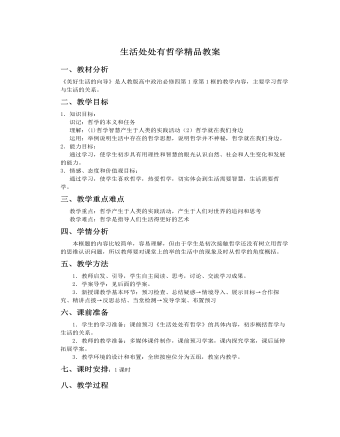
人教版高中政治必修4生活处处有哲学精品教案
(三)合作探究、精讲点拨。探究一:探究问题:如何看待排名一名高中生在谈到“排名的二重性”时说:“我们既不能盲目地张扬排名,也不能简单地否定排名。作为学生,如果用片面的观点对待排名,排在前面沾沾自喜、骄傲自满,排在后面灰心丧气、一蹶不振,就会停滞不前,甚至倒退;如果通过排名了解自己的学习实力以及同别人的差距,做到知彼知己,扬长避短,就会出现先进更先进、后进赶先进的生动局面。”问题:(1)在排名问题上,人们的看法往往各不相同,这是为什么?(2)为什么我们应看到排名的“二重性”?(3)联系生活中类似的事例,谈谈生活与哲学的关系。教师活动:指导学生阅读以上的材料,并思考所提问题。学生活动:阅读材料,分组讨论问题,发表自己的观点,分析材料中包含的哲学道理。教师点评:(1)在排名问题上,人们的看法不同,主要是因为人们的思维方法不同。

新人教版高中英语必修3Unit 1 Festivals and celebrations-Discovering Useful Structure教学设计
4.That was an experience that frightened everyone. →That was _____________________. 答案:1. taking 2. being discussed 3. in the reading room 4. a frightening experienceStep 6 The meaning and function of V-ing as the predicative动词-ing形式作表语,它通常位于系动词后面,用以说明主语“是什么”或“怎么样”一种表示主语的特质、特征和状态, 其作用相当于形容词; 另一种具体说明主语的内容, 即主语等同于表语, 两者可互换。The music they are playing sounds so exciting. 他们演奏的音乐听起来令人激动。The result is disappointing. 结果令人失望。Our job is playing all kinds of music. 我们的工作就是演奏各种音乐。Seeing is believing. 眼见为实。Step 7 Practice1. It is ________(amaze) that the boy is able to solve the problem so quickly.2. Buying a car is simply _______(waste) money. 3. Please stop making the noise—it’s getting ________(annoy). 4. complete the passage with the appropriate -ing form.La Tomatina is a festival that takes place in the Spanish town Bunol every August. I think many food festivals are __________ because people are just eating. however, this festival is _________ because people don't actually eat the tomatoes. Instead, they throw them at each other! the number of people ________ part in this tomato fight, can reach up to 20,000, and it is a very __________ fight that lasts for a whole hour. The _______ thing is how clean Bunol is after the tomatoes are washed away after the fight. this is because the juice form tomatoes is really good for making surfaces clean!答案:1. amazing 2. wasting 3. annoying4. boring interesting taking exciting amazing

新人教版高中英语必修3Unit 1 Festivals and Celebrations-Reading and Thinking教学设计
The topic of this part is “Discover the reasons for festivals and celebrations.The Listening & Speaking & Talking part aims at talking about the experiences and feelings or emotions about the festivals and celebrations. This section aims at detecting the reason why the people celebrate the festivals, the time, the places, the types and the way of celebrations. It also explains why some traditions in the old celebrations are disappearing, like the firecrackers in the big cities and some new things are appearing like the prosperity of business or commerce. 1. Students can talk about what festivals they know and the reasons and the way of celebrating them.2. Students should learn the reading skills such as the headline and get the topic sentences, the structures of articles.3. Students can understand the past, the present situation of some festival around the world and why there are some changes about them. 4. Students can have the international awareness about the festivals.1. Students should learn the reading skills such as the headline and get the topic sentences, the structures of articles.2. Students can understand the past, the present situation of some festival around the world and why there are some changes about them.Step 1 Lead in---Small talkWhat festival do you like best ? Why ?I like the Spring Festivals because I can set off the fireworks, receive the lucky money and enjoy the Gala with my families.Step 2 Before reading---Pair workWhy do people celebrate different festivals ?The Spring Festivals is to celebrate the end of winter and the coming of spring and new life.The Mid-autumn Day is to celebrate the harvest and admire the moon.

新人教版高中英语必修3Unit 1 Festivals and Celebrations-Listening &Speaking&Talking教学设计
The theme of this section is “Talk about festival activities and festival experiences”.Festival and holiday is a relaxing and interesting topic for students. This part talks about the topic from the daily life of students’. In the part A ---Listening and Speaking, there are three conversations among different speakers from three countries(Japan, Rio and China), where the speakers are participating in or going to participate in the festivals and celebrations. So listening for the relationship among them is a fundamental task. Actually, with the globalization and more international communication, it is normal for Chinese or foreigners to witness different festivals and celebrations in or out of China. In the Conversation 1, a foreign reporter is interviewing a Japanese young girl who just had participated in the ceremony of the Coming-of-Age Day on the street and asking her feeling about the ceremony and the afterwards activities. Conversation 2, Chinese girl Li Mei is witnessing the Rio Carnival for the first time, and her friend Carla gives her some advice on the costumes which enables her to match with the carnival to have a good time. Conversation 3, a Chinese guide is showing a group of foreign visitors around the Lantern Festival and introducing the customs of the festival to them. The three conversations have a strong vitality and insert the festival and cultural elements from different countries. So perceiving the festivals and cultures from different countries is the second task. At the same time, the scripts also insert the targeted grammar --- v-ing as attributive and predicative, which students can perceive and experience in a real context and make a road for the further study. That is the third task. In the Part B--- Listening and Talking, the theme is “Talk about festival experience”, which is the common topic in our daily conversations. During the conversation, Song Lin, a Chinese student, asked Canadian friend Max about how to spend Christmas. In the conversation, Song Lin talked about experience and the feelings during the Chinese Spring Festival, during which there are not only some enjoyable things but some unpleasant things. After the listening, perhaps students find there are some similarities between Christmas and the Chinese Spring Festival as there are some differences in the origins and celebrations. For example, people always visit friends and relatives, decorate their houses, have a big dinner together, chat and give presents to each other.

新人教版高中英语必修3Unit 1 Festivals and Celebrations-Reading for writing教学设计二
Step 3 Analyzing article structureActivity 31. Teachers raise questions to guide students to analyze the chapter structure of this diary and think about how to describe the festival experience. (1)What should be included in the opening/body/closing paragraph(s)?(2)How did the writer arrange his/her ideas?(3)What kind of interesting details did the writer describe?(4)How did the writer describe his/her feelings/emotions during the event?2. Students read and compare the three sentence patterns in activity 2. Try to rewrite the first paragraph of the diary with these three sentence patterns. After that, students exchange corrections with their partners. Such as:●This was my first time spending three days experiencing the Naadam Festival in China’s Inner Mongolia Autonomous Region and it was an enjoyable and exciting experience. ●I'll never forget my experience at the Naadam Festival because it was my first time to watch the exciting Mongolian games of horse racing, wrestling, and archery so closely. ●I'll always remember my first experience at the Naadam Festival in China’s Inner Mongolia Autonomous Region because it was so amazing to spend three days witnessing a grand Mongolian ceremony. Step 4 Accumulation of statementsActivity 41. Ask the students to read the diary again. Look for sentences that express feelings and emotions, especially those with the -ing form and the past participle. Such as:● …horse racing, wrestling, and archery, which are all so exciting to watch. ● some amazing performances● I was surprised to see…● I was a little worried about. . . ● feeling really tiredOther emotional statements:●I absolutely enjoyed the archery, too, but the horse races were my favourite part. ●I'm finally back home now, feeling really tired, but celebrating Naadam with my friend was totally worth it. ●He invited me back for the winter to stay in a traditional Mongolian tent and cat hot pot. I can’t wait!2. In addition to the use of the -ing form and the past participle, the teacher should guide the students in the appreciation of these statements, ask them to memorize them, and encourage them to use them reasonably in writing practice.

新人教版高中英语必修3Unit 1 Festivals and Celebrations-Reading for Writing教学设计一
The topic of this part is “Write about your festival experience”.During the Listening and Speaking and Talking, students are just asked to say out their festival experiences such as the Spring Festival, Mid-autumn Day, but this part students will be asked to write down their own festival experiences. During the reading part, it introduces the Naadam Festival in Inner Mongolia Autonomous Region, which can give students a good example to imitate. Students not only learn the festival, but touch and feel the Inner Mongolian’s character, the spirit and cultural atmosphere, which can help students form the cultural awareness and learn to enjoy and value the diversity of Chinese culture.Concretely, the dairy tells the experience that the author spent the Naadam Festival in Inner Mongolia Autonomous Region with his/her friend. The structure is clear. In the opening paragraph, it introduces the topic of the Naadam Festival and the whole feeling. Then it introduces the items of the festival like the ceremony, wrestling and horse racing. Finally, it summarizes this experience. Because this part is a travel journal, we must guide students pay more attention to these details: 1. use the first person. 2. use the past tense to tell the past thing and use the present or future tense to describe the scenery. 3. use the timeline to tell the development. 4. be careful for the author’s psychology, emotion and feeling, etc.1. Read quickly to get main idea; read carefully to get the detailed information about Naadam Festival.2. Learn the structure of the reading article and language.3. Write an article about a festival experience4. Learn to use the psychology, emotions and feeling in the writing.1. Write an article about a festival experience.2. Use the structure of the reading article and language.